|
 |
 Автор: Williams Автор: Williams
 Дата: 18 октября 2020 Дата: 18 октября 2020
 Просмотров: 17 558 Просмотров: 17 558 |
| |
SCAD (Structure CAD) Office v21.1.9.7 build 23/06/2020
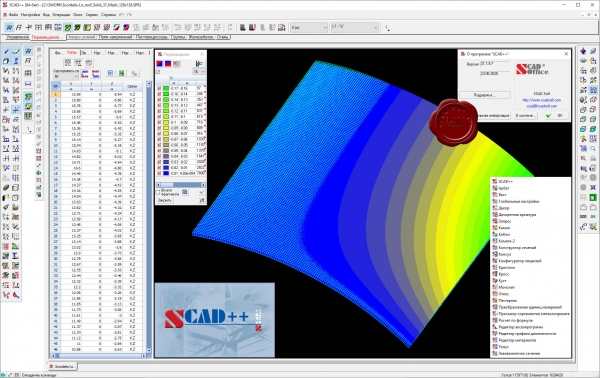
SCAD Office - система нового поколения, разработанная инженерами для инженеров и реализованная коллективом опытных программистов. В состав системы входит высокопроизводительный вычислительный комплекс SCAD, а также ряд проектирующих и вспомогательных программ, которые позволяют комплексно решать вопросы расчета и проектирования стальных и железобетонных конструкций. Система постоянно развивается, совершенствуются интерфейс пользователя и вычислительные возможности, включаются новые проектирующие компоненты.
SCAD Office сертифицирован на соответствие ГОСТ Р ИСО/МЭК 9126-93, ГОСТ 28195-89, ГОСТ Р ИСО 9127-94, РД 50-34.698-90
Соответствие СНиП подтверждено сертификатом Госстроя России.
SCAD Office включает следующие программы:
- SCAD - вычислительный комплекс для прочностного анализа конструкций методом конечных элементов
- КРИСТАЛЛ - расчет элементов стальных конструкций
- АРБАТ - подбор арматуры и экспертиза элементов железобетонных конструкций
- КАМИН - расчет каменных и армокаменных конструкций
- ДЕКОР - расчет деревяных конструкций
- ЗАПРОС - расчет элементов оснований и фундаментов
- ОТКОС - анализ устойчивости откосов и склонов
- ВЕСТ - расчет нагрузок по СНиП "Нагрузки и воздействия" и ДБН
- МОНОЛИТ - проектирование монолитных ребристых перекрытий
- КОМЕТА, КОМЕТА-2 - расчет и проектирование узлов стальных конструкций
- КРОСС - расчет коэффициентов постели зданий и сооружений на упругом основании
- КОНСТРУКТОР СЕЧЕНИЙ - формирование и расчет геометрических характеристик сечений из прокатных профилей и листов
- КОНСУЛ - построение произвольных сечений и расчет их геометрических характеристик на основе теории сплошных стержней
- ТОНУС - построение произвольных сечений и расчет их геометрических характеристик на основе теории тонкостенных стержней
- СЕЗАМ - поиск эквивалентных сечений
- КоКон - справочник по коэффициентам концентрации напряжений и коэффициентам интенсивности напряжений
- КУСТ - расчетно-теоретический справочник проектировщика
ОСОБЕННОСТИ ДАННОГО РЕЛИЗА
0. Патч не полный. К тому же - от одной из предыдущих версий. Исходя из этого ->
1. Максимальная доступная версия Pro. Доступна только лицензия на линейный расчет. Результаты сопадают. Нелинейную статику проверить не удалось. Для нее нужна лицензия Promax.
2. По той же причине отсутствует возможность расчета АЧХ и спектра ответа.
3. Модуль "Монтаж" ругается на отсутствие лицензии на использование данной функции. Это относительно новый модуль, а прокси длл от старых версий, когда его еще не было.
4. К сателлитам никаких нареканий не выявлено. |
| |
 Читать статью дальше (комментариев - 36)
Читать статью дальше (комментариев - 36)
| |
|
 |
 Автор: Williams Автор: Williams
 Дата: 16 октября 2020 Дата: 16 октября 2020
 Просмотров: 2 755 Просмотров: 2 755 |
| |
PSISuite3D
Over the past decade, PSI Technologies has developed advanced mechanistic materials characterization and true three-dimensional numerical modeling techniques for the transportation sector. These efforts have created a powerful suite of world-class modeling tools called PSISuite3D. PSISuite3D predicts pavement performance such as cracks and rutting over the short and long term of a road’s lifecycle – powerful information for preventing deterioration and for ongoing infrastructure lifecycle budget planning.
PSISuite3D includes:
- PSIPave3D: Pavement Structural Analysis
- PSICulvert3D: Culvert Analysis
- PSIUtility3D: Urban Buried Infrastructure Analysis
- PSIHeavyHaul3D: Custom Heavy Haul Analysis
- PSIGeosynthetics3D: Geosynthetic Layers Analysis
- PSIDrainage3D: Drainage System Analysis
- PSIMultiscale3D: Micro- and Macro-Scale Simulations
- PSIBackCalc3D: Viscoelastic Layer Moduli Backcalculation Analysis
- PSIPad3D: Heavy Industrial Pads Analysis
Using the PSISuite3D modeling system, alternative designs can be tried and tested before construction, identifying problems in virtual space and preventing costly real-world building and maintenance issues.
|
| |
 Читать статью дальше (комментариев - 72)
Читать статью дальше (комментариев - 72)
| |
|
 |
 Автор: Williams Автор: Williams
 Дата: 16 октября 2020 Дата: 16 октября 2020
 Просмотров: 3 592 Просмотров: 3 592 |
| |
САПРОТОН NormCAD v11.6 x32+x64
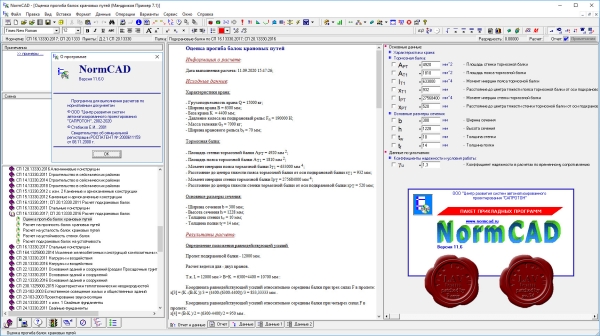
NormCAD выполняет расчеты строительных конструкций по СНиП и готовит проектную документацию для представления заказчику и в органы экспертизы:
- расчет стальных конструкций (расчет балок, колонн сплошного и составного сечения, профнастила и узлов ферм из гнутых профилей);
- расчет железобетонных конструкций (расчет балок, колонн, стен и плит: подбор арматуры, проверка сечений - в т.ч. тавровых и двутавровых, косое внецентренное сжатие, расчет круглых колонн и колонн с распределенной арматурой, трещиностойкость, проверка прогиба, расчет на смятие и продавливание);
- расчет каменных и армокаменных конструкций (проверка сечений - прямоугольных и тавровых на центральное и внецентренное сжатие, растяжение, срез, трещиностойкость и смятие);
- расчет фундаментов;
- теплотехнический расчет (сопротивление теплопередаче и паропроницанию стен, покрытий, перекрытий и светопрозрачных конструкций).
- другие строительные и машиностроительные расчеты.
Главное преимущество - на сегодня это единственная программа, в которой расчет оформляется в виде текстового документа (в формате Word), подобному созданному опытным конструктором вручную, что позволяет легко проконтролировать любую часть расчета.
О новом в версии 11.6 тут |
| |
 Читать статью дальше (комментариев - 17)
Читать статью дальше (комментариев - 17)
| |
|
 |
 Автор: Williams Автор: Williams
 Дата: 15 октября 2020 Дата: 15 октября 2020
 Просмотров: 5 837 Просмотров: 5 837 |
| |
Carlson Civil Suite 2021 build 200918 x64
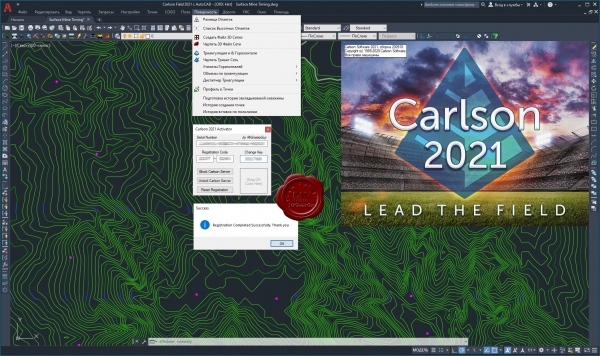
Carlson Civil Suite 2021 - пакет прикладных программ на плаформах AutoCAD 2000-2021 и IntelliCAD для работ по геодезии, геологии, построения цифровых моделей местности, проектирования генпланов, ГИС, добычи полезных ископаемых. Полная версия Carlson Civil Suite 2021 включает в себя данные программы: Survey, Civil Design, Hydrology, GIS, Construction, Takeoff, Field, Natural Regrade, Point Cluids, Basic Mining, GeoTech, Geology, Underground Mining, Surface Mining и SurvGNSS. Эти модули могут работать как совместно, так и раздельно.
Функциональные возможности:
- автоматизация обработки данных геодезической съемки;
- ввод и анализ данных по скважинам, построение геологической модели месторождения;
- построение геологических карт в изолиниях, разрезов;
- оценка запасов;
- проектирование открытых и подземных работ;
- планирование добычи и определение графиков загрузки оборудования.
Видеоролики по работе программы можно найти здесь: link |
| |
 Читать статью дальше (комментариев - 13)
Читать статью дальше (комментариев - 13)
| |
|
 |
 Автор: Williams Автор: Williams
 Дата: 14 октября 2020 Дата: 14 октября 2020
 Просмотров: 1 701 Просмотров: 1 701 |
| |
DesignSense GeoTools v21.12
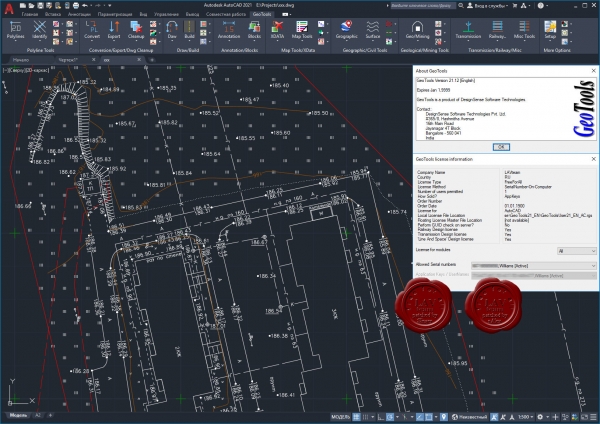
GeoTools is an add-on program for AutoCAD and Bricscad which provides you with a number of useful productivity tools that are designed exclusively for the geographic data user. It is a heterogenous collection of CAD tools that are useful for users in the mapping, surveying, GIS, facilities planning, real estate and infrastructure management industry.
GeoTools is a time-saver productivity tools built for geo-data using CAD users who want to work smart and not hard. In the AutoCAD version of GeoTools, there are a large number of AutoCAD Map tools as well that making working with object data a breeze.
GeoTools functions are arranged in easily categorized pull-down menus, toolbars and also as tabbed ribbons in AutoCAD 2013 and later versions. Some of the borad category of tools you will find in GeoTools are Polyline, Annotation, Drawing Cleanup, Digitizing, AutoCAD Map, Inquiry and so on. |
| |
 Читать статью дальше (комментариев - 10)
Читать статью дальше (комментариев - 10)
| |
|
 |
 Автор: Williams Автор: Williams
 Дата: 13 октября 2020 Дата: 13 октября 2020
 Просмотров: 833 Просмотров: 833 |
| |
DesignSense CADPower v21.12
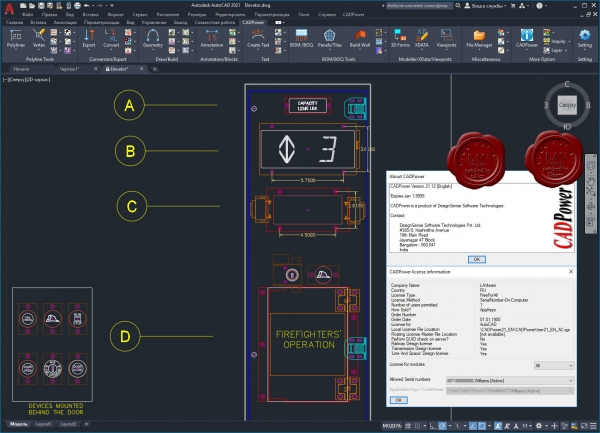
CADPower is an add-on software to help you increase your productivity with AutoCAD and Bricscad. It helps you work smarter, faster and eliminates various bottleneck you might face using just your CAD software. In short, CADPower adds more value and power to your CAD software. CADPower is a collection of frequently asked tools for various CAD operations. The tools are categorized in easily accessible categories like Polyline, Blocks, Attributes, Draw, Selection, Inquiry, Miscellaneous and so on. They are available as pull-down menus, toolbars, tabbed ribbons (AutoCAD 2012 and later), as well as from the command-line as directly callable commands. Most of the commands also offer command-line versions (without dialog boxes) which can also be used in automated processing using scripts. |
| |
 Читать статью дальше (комментариев - 6)
Читать статью дальше (комментариев - 6)
| |
|
 |
 Автор: Williams Автор: Williams
 Дата: 12 октября 2020 Дата: 12 октября 2020
 Просмотров: 2 925 Просмотров: 2 925 |
| |
ASVIC Mech-Q Full Suite v4.21.100 for AutoCAD 2000-2021 x32+x64
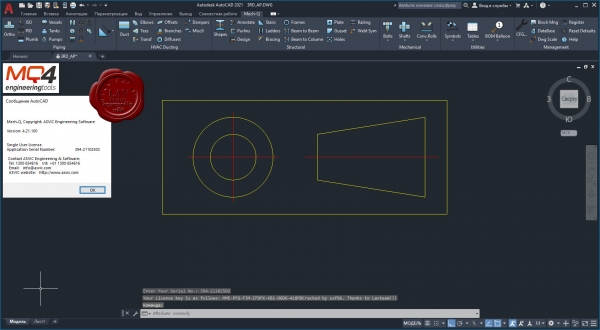
If your looking for powerful Engineering Software that that gets the job done, look no further. Mech-Q is AutoCAD Mechanical, Structural, HVAC, and Piping all in one suite!
Features:
- Comprehensive pipe, fittings, and valves.
- Create Rectangular, round and flat oval ducting.
- Includes range of mechanical symbols & housings, gears and more.
- Create steel details, shapes, stairs and more.
|
| |
 Читать статью дальше (комментариев - 14)
Читать статью дальше (комментариев - 14)
| |
|
 |
 Автор: Williams Автор: Williams
 Дата: 11 октября 2020 Дата: 11 октября 2020
 Просмотров: 1 349 Просмотров: 1 349 |
| |
DotSoft C3DTools v9.0.0.7
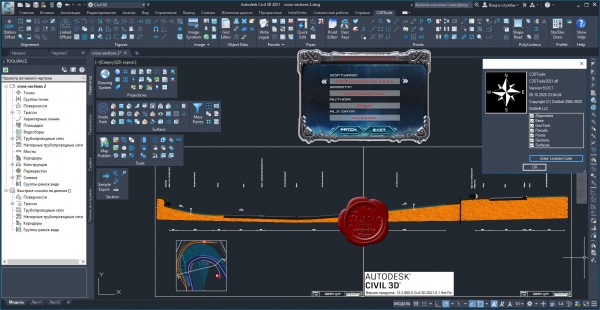
C3DTools is a collection of Civil/Survey Mapping & GIS tools specifically for Civil3D (2015 & Higher). It is a modular system covering the major areas of alignments, design, geotech, parcels, points, sections, surfaces, and more.
|
| |
 Читать статью дальше (комментариев - 8)
Читать статью дальше (комментариев - 8)
| |
|
 |
 Автор: Williams Автор: Williams
 Дата: 10 октября 2020 Дата: 10 октября 2020
 Просмотров: 4 707 Просмотров: 4 707 |
| |
Geo-Plus VisionLidar Ultimate v30.0.01.116.20 x64
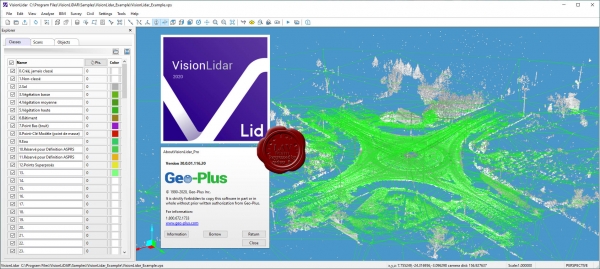
Introducing the new AI object recognition tool. Now integrating artificial intelligence, VisionLidar object recognition tool allows to manage a point cloud in a much simpler way. Automatically detecting clusters of points, and recognizing any object's geometry. The most complete Point Cloud software so far, VisionLiDAR allows to use 50, 100 and more billions of points.
|
| |
 Читать статью дальше (комментариев - 28)
Читать статью дальше (комментариев - 28)
| |
|
 |
 Автор: Williams Автор: Williams
 Дата: 9 октября 2020 Дата: 9 октября 2020
 Просмотров: 6 819 Просмотров: 6 819 |
| |
SOFiSTiK BIM Apps 2021 (for Revit 2021):
Analysis + Design v6.0.333, Bridge + Infrastructure Modeler v6.0.164, Reinforcement Detailing v6.0.163,
Reinforcement Generation v5.0.49, BiMTOOLS v5.0.58, 3D-PDF Export v5.0.26
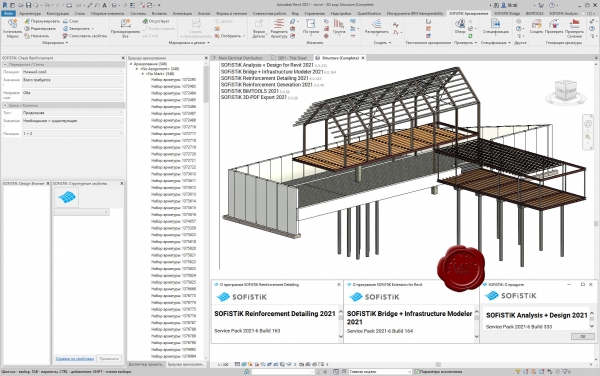
SOFiSTiK Analysis + Design enables you to perform structural analyses of buildings and member design directly in Autodesk Revit. The App provides for a full Finite Element Analysis and design workflow – from model consistency checks to code checking for concrete members like slabs, columns, and beams. Structural analyses can be performed in 3D – allowing for realistic simulation of the structural stiffness and optional consideration of the construction sequence. Additionally 2D and 3D subsystems can be adopted in combination with an automatic load takedown. Members can be grouped and accordingly designed in Ultimate and Serviceability Limit States. Calculation and design reports will be generated automatically. Results can be visualized and managed in Revit or be transferred to spreadsheets for further processing using the Export to Excel function. Together with the full support of collaboration features, SOFiSTiK Analysis + Design enables a seamless structural analysis workflow within Revit. When installed with SOFiSTiK 2020, the app enhances into a Revit interface for the full SOFiSTiK FEA.
SOFiSTiK Bridge Modeler supports BIM in Bridge Design and Detailing. The application allows users to create parametrized 3D bridge models using alignment parameters and generic families in Autodesk Revit. The product consists of the software itself and content including generic families for super- and substructure creation. These families can be easily modified or created from scratch to meet local and company standards. Additional bridge equipment elements such as parapets and railings can also be created. Automatic generation of section views, top views, longitudinal sections, and elevation points-assists users in detailing and documenting their structures.
SOFiSTiK Reinforcement Detailing significantly accelerates the creation of 2D reinforcement sheets out of 3D models in Autodesk Revit. The product consists of software and a set of families, which can easily be modified to meet local or company standards. Creation of bar lists, bending schedules and cut lists for wire meshes is included as well.
SOFiSTiK Reinforcement Generation automatically generates a 3D rebar model inside of Autodesk Revit based on computed analysis and design results. The rebar model provides an automatically generated proposition of reinforcement layout which fulfils the reinforcement requirement and which can be freely modified. Design requirements from construction codes and company standards can be controlled by user-defined rules similar to the approach used in expert systems. Visualization of existing reinforcement vs. required reinforcement provides a clear indication whether adequate reinforcement has been provided.
SOFiSTiK BiMTOOLS are a set of free tools for Autodesk Revit which enhances the productivity for elaborations of views up to 50%. Functionalities at a glance - Substitution of Font Type; Read out of Coordinates; Create Views of Elements; Positioning of Elements; Automatic Dimensioning; Selective tagging; Hiding of categories not to be plotted; Altitude of Openings; Formwork area; Copy mounting parts; Assign the mark of the host.
SOFiSTiK 3D-PDF Export extends the functionalities of Autodesk Revit through the generation of standard PDF documents with embedded 3D graphics. The 3D-PDF files can be opened by any PDF reader that supports the PDF 1.6 standard, such as Adobe Reader 7.0 or later. SOFiSTiK 3D-PDF Export uses the geometric definition of the elements in order to create an equivalent representation of the model in U3D format. Descriptive information about the particular Revit objects is embedded.
|
| |
 Читать статью дальше (комментариев - 39)
Читать статью дальше (комментариев - 39)
| |
|
 |
| ПОИСК ПО САЙТУ |
 |
|
 |
| КАЛЕНДАРЬ | | |
 |
| « Октябрь 2025 » |
|---|
| Пн | Вт | Ср | Чт | Пт | Сб | Вс |
|---|
| | 1 | 2 | 3 | 4 | 5 | | 6 | 7 | 8 | 9 | 10 | 11 | 12 | | 13 | 14 | 15 | 16 | 17 | 18 | 19 | | 20 | 21 | 22 | 23 | 24 | 25 | 26 | | 27 | 28 | 29 | 30 | 31 | |
|
 | |
| |
|